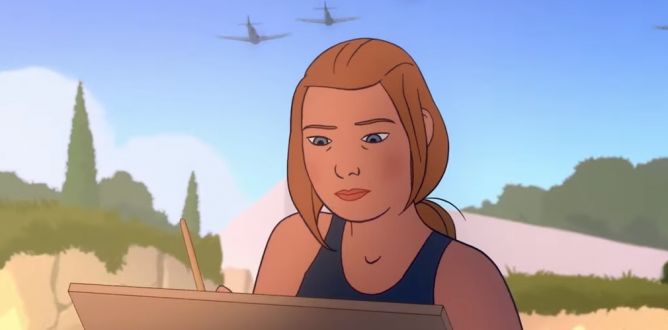Charlotte Parent Guide
This animated film tells a powerful story of a courageous, talented woman forced to battle her family history and the tides of history.
Parent Movie Review
“What matters isn’t whether life loves us but whether we love life.” Given to Charlotte Salomon in her late teens, this advice becomes a touchstone for her life. As the rise of Nazism forces the Jewish artist to flee to France, Charlotte holds on to her love of life and vows to record the entire story of her family in paint. With over 1000 works completed in gouache in a few short years, Charlotte achieves her goal, leaving art lovers with an engrossing treasury of fiercely brilliant, vibrantly colored masterpieces.
This animated film doesn’t gloss over the real-life trials and tragedies that haunt Charlotte and shadow her work. Her mother’s death during her childhood is a lasting grief, her grandfather is a difficult and demanding man, and the anti-Semitism of the Nazi regime thwarts her artistic education. Mental illness and suicide pervade her extended family and are yet an additional burden for the young woman to carry. Remarkably, despite the grimness that surrounds her, her work endures as a triumphant witness to the power of her humanity, vision, and talent.
Charlotte contains strong themes of persistence and dedication and offers dazzling animations of art in progress. However, it is definitely not a suitable movie for children, coming in at the intersection of the PG-13 and Restricted ratings. There is plenty of violence, including scenes of Nazis attacking and herding Jews at gunpoint and an extended sequence of the thuggish bruality of Kristallnacht. Suicide is also a motif in the story, with past tragedies recounted and a character who tries to kill herself, eventually succeeding in a later attempt. Finally, the plot features a murder – not something normally found in family-friendly cinema. I am unwilling to provide a spoiler, but what I can say is that the script’s sanitization of past issues removes the context from the murder, making it less comprehensible than it would be if the story were told more fully.
The movie also surprises – and not in a good way – with its sexual content. There are two scenes featuring nude adults wrapped around each other. Breasts and genitals are not visible, but the couples are clearly involved in sexual activity. Again, this isn’t suitable for young viewers.
Content issues aside, Charlotte stands out thanks to its unique production design. The voice cast are excellent, imbuing characters with personalities that don’t easily come through the rather flat animation. The animation is spotty: it shines while showing paintings in process and in some beautiful backgrounds. It’s often stiff and jerky with figures, which can distract from the story. Using animation for Charlotte’s life story is a brilliant idea; I only wish the animation resembled her paintings more closely. I would have liked to see a gouache look to the film and I think it would benefit from some slightly fantastical touches. The latter would move away from the Saturday morning cartoon stiffness that gets in the way of this incredible real-life story of a brilliant life snuffed out by hate.
Directed by Tahir Rana and Eric Warin. Starring Keira Knightley, Marion Cotillard, Brenda Blethyn, Jim Broadbent, Sam Claflin, Mark Strong. Running time: 92 minutes. Theatrical release April 22, 2022. Updated January 13, 2024Watch the trailer for Charlotte
Charlotte
Rating & Content Info
Why is Charlotte rated Not Rated? Charlotte is rated Not Rated by the MPAA
Violence: There are scenes of violence committed by Nazis: intimidation, beatings, forcing people away at gunpoint, seizing people from their homes. Nazis burn books and art. Buildings are seen burning due to arson. Concentration camps are briefly mentioned and swastikas are seen. A man is seen scarred and bruised after being tortured. There is brief mention of the death of a parent from influenza. Suicide is mentioned in the context of past deaths. A person mentions a suicide plan for the future. A character begs to be able to die. A person tries to hang herself and then succeeds after she throws herself from a window. A person remembers being buried with corpses during the war. Painted images of war scenes are shown. A distraught man strikes a young woman. A man is struck and shown bleeding. A person poisons someone else and their dead body is seen afterwards. Soldiers beat a man with rifles. A pregnant woman is heard screaming as soldiers abduct her: the action takes place off screen.
Sexual Content: There are scenes of a man and woman kissing and embracing. A naked man is seen from behind in the context of a painting class. Nude figures are seen in paintings. A naked couple are seen embracing from a side view: sex is implied. An unmarried woman learns that she’s pregnant. A naked couple are seen in a post-coital moment: sex occurred outdoors but no breasts or genitals are visible.
Profanity: There are four terms of deity in the film.
Alcohol / Drug Use: Main characters drink alcohol in a bar: it’s possible one is underage but that is not clear. A person is given morphine by a physician. Adults drink champagne at a wedding party. A person is deliberately poisoned with a prescription drug.
Page last updated January 13, 2024
Charlotte Parents' Guide
You can learn more about Charlotte Salomon’s life and work below:
The New Yorker: The Obsessive Art and Great Confession of Charlotte Salomon
Wikipedia: Charlotte Salomon
Smithsonian Magazine: The Genre-Bending, Death-Defying Triumph of Charlotte Salmon’s Art
The Guardian: A spirit the Nazis couldn’t erase
Loved this movie? Try these books…
Appropriately, a biography of Charlotte Salomon is available in graphic novel form. Entitled Charlotte Salomon: Colors of the Soul it was written by Ilaria Ferramosca and illustrated by Gian Marco de Francisco.
Teen readers can also find a more traditional biography written by Susan Wider and entitled It’s My Whole Life: Charlotte Salomon: An Artist in Hiding During World War II.
Adults wanting more information about the artist can read Charlotte Salomon and the Theatre of Memory by Griselda Pollock or Charlotte Salomon. Life? Or Theatre? By Judith CE Belinfante and Evelyn Benesch.
Home Video
Related home video titles:
When a man is forced to leave Afghanistan under the Taliban regime, he becomes a refugee. Flee tells his story through animation mixed with news footage. The hardships of life under the Taliban are starkly told in The Breadwinner, an animated tale of a girl who dresses as a boy so she can earn money to support her family.
Vincent Van Gogh’s life story is told in Loving Vincent. This stunning film uses oil painted animation, providing a distinct look at the great man’s art.
Issues of art, forgery, collaboration, deceit, and justice come together in The Last Vermeer. In this true story, an art collector is charged with selling cultural treasures to the Nazis, only to insist that he sold them forgeries. Now he has to prove that he has the skill.

